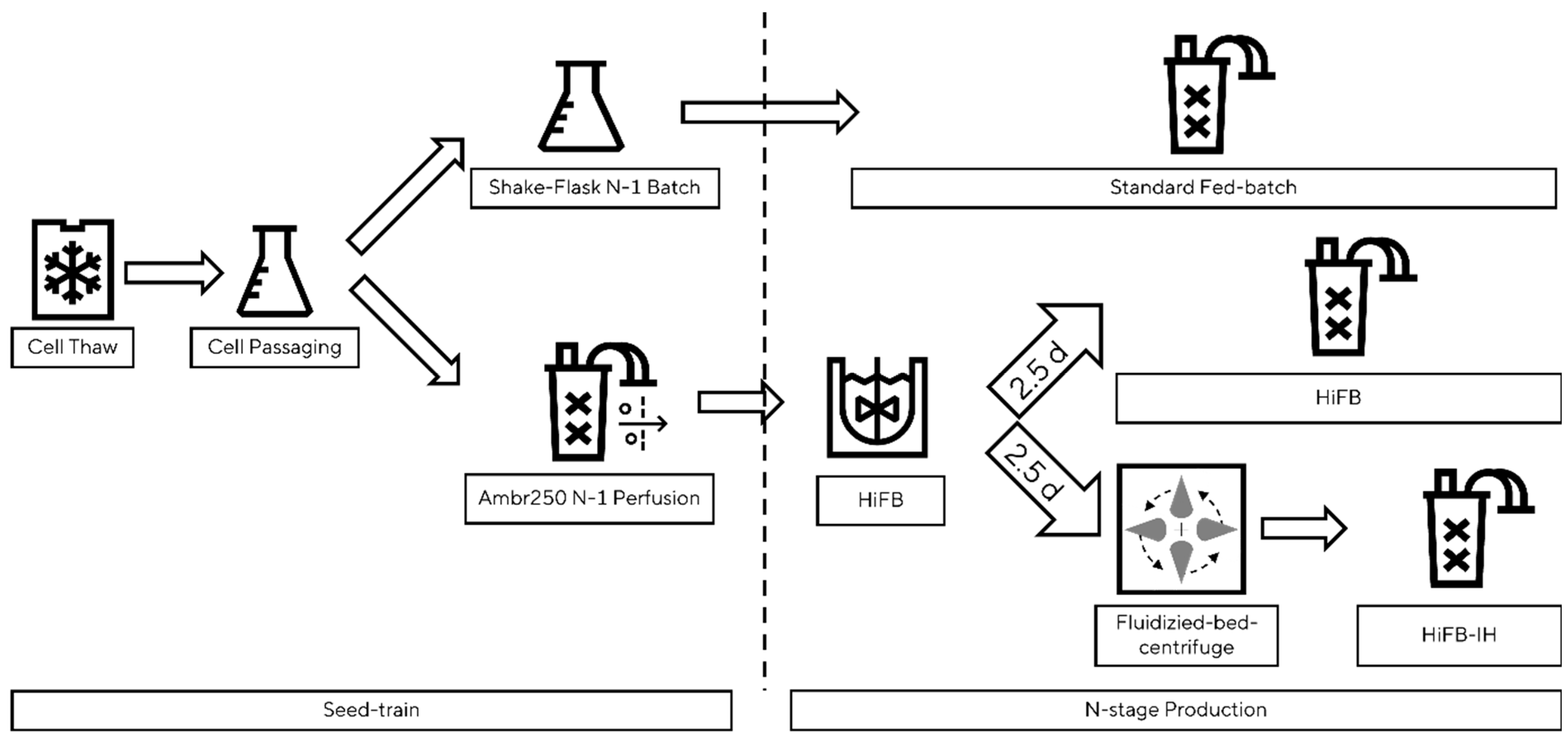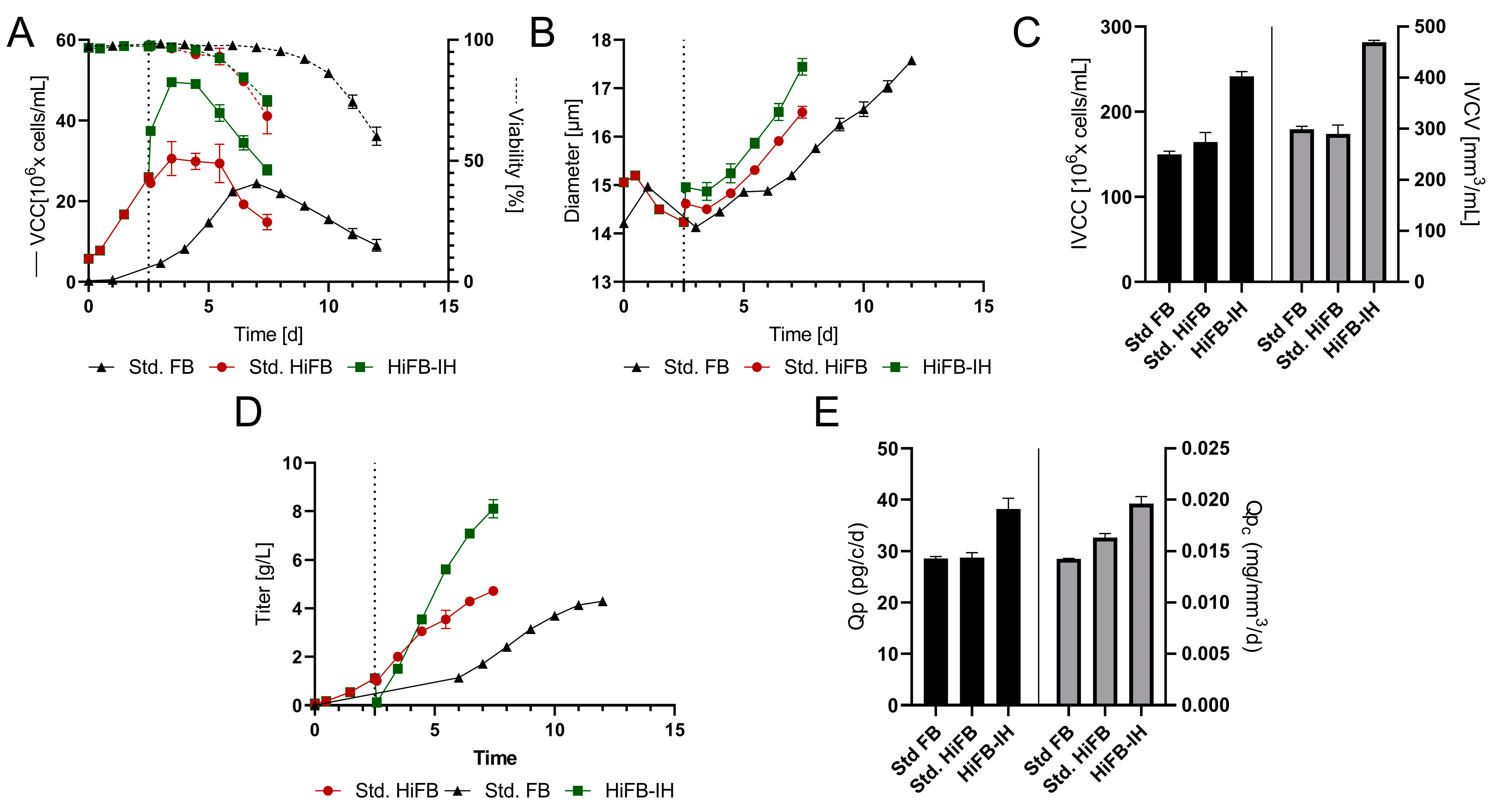Triple Space-Time Yield in Discontinuous Antibody Biomanufacturing by Combination of Synergetic Process Intensification Strategies
Abstract
:1. Introduction
2. Materials and Methods
2.1. The Cell Culture System
2.2. Small-Scale Cultivation
2.3. Proof of Concept
2.4. Cell Wash and Concentration
2.5. Analytics
3. Results
3.1. Small-Scale Experiments
3.2. Proof of Concept
3.3. Space-Time Yield and Glycosylation
4. Discussion
4.1. Process Characterization and Comparison
4.2. Quality Assessments
4.3. Differences in Scales
4.4. Economical Classification
5. Conclusions
Supplementary Materials
Author Contributions
Funding
Institutional Review Board Statement
Informed Consent Statement
Data Availability Statement
Acknowledgments
Conflicts of Interest
References
- Bashir, M.F.; Ma, B.; Shahzad, L. A brief review of socio-economic and environmental impact of COVID-19. Air Qual. Atmos. Health 2020, 13, 1403–1409. [Google Scholar] [CrossRef] [PubMed]
- Wouters, O.J.; Shadlen, K.C.; Salcher-Konrad, M.; Pollard, A.J.; Larson, H.J.; Teerawattananon, Y.; Jit, M. Challenges in ensuring global access to COVID-19 vaccines: Production, affordability, allocation, and deployment. Lancet 2021, 397, 1023–1034. [Google Scholar] [CrossRef] [PubMed]
- Sidebottom, D.B.; Gill, D. Ronapreve for prophylaxis and treatment of covid-19. BMJ 2021, 374, n2136. [Google Scholar] [CrossRef] [PubMed]
- Chavda, V.P.; Prajapati, R.; Lathigara, D.; Nagar, B.; Kukadiya, J.; Redwan, E.M.; Uversky, V.N.; Kher, M.N.; Patel, R. Therapeutic monoclonal antibodies for COVID-19 management: An update. Expert Opin. Biol. Ther. 2022, 22, 763–780. [Google Scholar] [CrossRef] [PubMed]
- Joe, C.C.D.; Segireddy, R.R.; Oliveira, C.; Berg, A.; Li, Y.; Doultsinos, D.; Chopra, N.; Scholze, S.; Ahmad, A.; Nestola, P.; et al. Accelerating manufacturing to enable large-scale supply of a new adenovirus-vectored vaccine within 100 days. bioRxiv 2021, 37. [Google Scholar] [CrossRef]
- Schulze, M. Process Intensification for CHO Cell Biomanufacturing. Ph.D. Thesis, Wageningen University, Wageningen, The Netherlands, 2023. [Google Scholar]
- Gillespie, D.E.; Rader, R.A. 18th Annual Report and Survey of Biopharmaceutical Manufacturing Capacity and Production; A Study of Biotherapeutic Developers and Contract Manufacturing Organizations; BioPlan Associates: Rockville, MD, USA, 2021. [Google Scholar]
- Walsh, G.; Walsh, E. Biopharmaceutical benchmarks 2022. Nat. Biotechnol. 2022, 40, 1722–1760. [Google Scholar] [CrossRef]
- Kim, J.Y.; Kim, Y.-G.; Lee, G.M. CHO cells in biotechnology for production of recombinant proteins: Current state and further potential. Appl. Microbiol. Biotechnol. 2012, 93, 917–930. [Google Scholar] [CrossRef]
- Kreye, S.; Stahn, R.; Nawrath, K.; Goralczyk, V.; Zoro, B.; Goletz, S. A novel scale-down mimic of perfusion cell culture using sedimentation in an automated microbioreactor (SAM). Biotechnol. Prog. 2019, 35, e2832. [Google Scholar] [CrossRef]
- Chen, C.; Wong, H.E.; Goudar, C.T. Upstream process intensification and continuous manufacturing. Curr. Opin. Chem. Eng. 2018, 22, 191–198. [Google Scholar] [CrossRef]
- Pollock, J.; Ho, S.V.; Farid, S.S. Fed-batch and perfusion culture processes: Economic, environmental, and operational feasibility under uncertainty. Biotechnol. Bioeng. 2013, 110, 206–219. [Google Scholar] [CrossRef]
- Martínez, V.S.; Buchsteiner, M.; Gray, P.; Nielsen, L.K.; Quek, L.-E. Dynamic metabolic flux analysis using B-splines to study the effects of temperature shift on CHO cell metabolism. Metab. Eng. Commun. 2015, 2, 46–57. [Google Scholar] [CrossRef] [PubMed]
- Oguchi, S.; Saito, H.; Tsukahara, M.; Tsumura, H. pH Condition in temperature shift cultivation enhances cell longevity and specific hMab productivity in CHO culture. Cytotechnology 2006, 52, 199–207. [Google Scholar] [CrossRef] [PubMed]
- Yang, W.C.; Lu, J.; Nguyen, N.B.; Zhang, A.; Healy, N.V.; Kshirsagar, R.; Ryll, T.; Huang, Y.-M. Addition of valproic acid to CHO cell fed-batch cultures improves monoclonal antibody titers. Mol. Biotechnol. 2014, 56, 421–428. [Google Scholar] [CrossRef] [PubMed]
- Hiller, G.W.; Ovalle, A.M.; Gagnon, M.P.; Curran, M.L.; Wang, W. Cell-controlled hybrid perfusion fed-batch CHO cell process provides significant productivity improvement over conventional fed-batch cultures. Biotechnol. Bioeng. 2017, 114, 1438–1447. [Google Scholar] [CrossRef] [PubMed]
- Yongky, A.; Xu, J.; Tian, J.; Oliveira, C.; Zhao, J.; McFarland, K.; Borys, M.C.; Li, Z.J. Process intensification in fed-batch production bioreactors using non-perfusion seed cultures. mAbs 2019, 11, 1502–1514. [Google Scholar] [CrossRef] [PubMed]
- Yang, W.C.; Lu, J.; Kwiatkowski, C.; Yuan, H.; Kshirsagar, R.; Ryll, T.; Huang, Y.-M. Perfusion seed cultures improve biopharmaceutical fed-batch production capacity and product quality. Biotechnol. Prog. 2014, 30, 616–625. [Google Scholar] [CrossRef]
- Reger, L.N.; Saballus, M.; Matuszczyk, J.; Kampmann, M.; Wijffels, R.H.; Martens, D.E.; Niemann, J. Boosting Productivity for Advanced Biomanufacturing by Re-Using Viable Cells. Front. Bioeng. Biotechnol. 2023, 11, 1106292. [Google Scholar] [CrossRef]
- Saballus, M.; Nisser, L.; Kampmann, M.; Greller, G. A novel clarification approach for intensified monoclonal antibody processes with 100 million cells/mL using a single-use fluidized bed centrifuge. Biochem. Eng. J. 2021, 167, 107887. [Google Scholar] [CrossRef]
- Alsayyari, A.A.; Pan, X.; Dalm, C.; van der Veen, J.W.; Vriezen, N.; Hageman, J.A.; Wijffels, R.H.; Martens, D.E. Transcriptome analysis for the scale-down of a CHO cell fed-batch process. J. Biotechnol. 2018, 279, 61–72. [Google Scholar] [CrossRef]
- Janoschek, S.; Schulze, M.; Zijlstra, G.; Greller, G.; Matuszczyk, J. A protocol to transfer a fed-batch platform process into semi-perfusion mode: The benefit of automated small-scale bioreactors compared to shake flasks as scale-down model. Biotechnol. Prog. 2019, 35, e2757. [Google Scholar] [CrossRef]
- Reger, L.N.; Saballus, M.; Kappes, A.; Kampmann, M.; Wijffels, R.H.; Martens, D.E.; Niemann, J. A novel hybrid bioprocess strategy addressing key challenges of advanced biomanufacturing. Front. Bioeng. Biotechnol. 2023, 11, 35. [Google Scholar] [CrossRef] [PubMed]
- Stepper, L.; Filser, F.A.; Fischer, S.; Schaub, J.; Gorr, I.; Voges, R. Pre-stage perfusion and ultra-high seeding cell density in CHO fed-batch culture: A case study for process intensification guided by systems biotechnology. Bioprocess Biosyst. Eng. 2020, 43, 1431–1443. [Google Scholar] [CrossRef] [PubMed]
- Pan, X.; Dalm, C.; Wijffels, R.H.; Martens, D.E. Metabolic characterization of a CHO cell size increase phase in fed-batch cultures. Appl. Microbiol. Biotechnol. 2017, 101, 8101–8113. [Google Scholar] [CrossRef] [PubMed]
- Alhuthali, S.; Kotidis, P.; Kontoravdi, C. Osmolality Effects on CHO Cell Growth, Cell Volume, Antibody Productivity and Glycosylation. Int. J. Mol. Sci. 2021, 22, 3290. [Google Scholar] [CrossRef] [PubMed]
- Ben Yahia, B.; Piednoir, A.; Dahomais, T.; Eggermont, S.; Paul, W. “Organized stress” for robust scale-up of intensified production process with fed-batch seed bioreactor. Biotechnol. Bioeng. 2023, 120, 2509–2522. [Google Scholar] [CrossRef] [PubMed]
- Gomez, N.; Lull, J.; Yang, X.; Wang, Y.; Zhang, X.; Wieczorek, A.; Harrahy, J.; Pritchard, M.; Cano, D.M.; Shearer, M.; et al. Improving product quality and productivity of bispecific molecules through the application of continuous perfusion principles. Biotechnol. Prog. 2020, 36, e2973. [Google Scholar] [CrossRef] [PubMed]
- Reinhart, D.; Damjanovic, L.; Kaisermayer, C.; Sommeregger, W.; Gili, A.; Gasselhuber, B.; Castan, A.; Mayrhofer, P.; Grünwald-Gruber, C.; Kunert, R. Bioprocessing of Recombinant CHO-K1, CHO-DG44, and CHO-S: CHO Expression Hosts Favor Either mAb Production or Biomass Synthesis. Biotechnol. J. 2019, 14, e1700686. [Google Scholar] [CrossRef] [PubMed]
- Kuriakose, A.; Chirmule, N.; Nair, P. Immunogenicity of Biotherapeutics: Causes and Association with Posttranslational Modifications. J. Immunol. Res. 2016, 2016, 1298473. [Google Scholar] [CrossRef]
- Zhou, Q.; Shankara, S.; Roy, A.; Qiu, H.; Estes, S.; McVie-Wylie, A.; Culm-Merdek, K.; Park, A.; Pan, C.; Edmunds, T. Development of a simple and rapid method for producing non-fucosylated oligomannose containing antibodies with increased effector function. Biotechnol. Bioeng. 2008, 99, 652–665. [Google Scholar] [CrossRef]
- Raju, T.S. Terminal sugars of Fc glycans influence antibody effector functions of IgGs. Curr. Opin. Immunol. 2008, 20, 471–478. [Google Scholar] [CrossRef]
- Herscovics, A. Importance of glycosidases in mammalian glycoprotein biosynthesis. Biochim. Et Biophys. Acta 1999, 1473, 96–107. [Google Scholar] [CrossRef] [PubMed]
- Pacis, E.; Yu, M.; Autsen, J.; Bayer, R.; Li, F. Effects of cell culture conditions on antibody N-linked glycosylation--what affects high mannose 5 glycoform. Biotechnol. Bioeng. 2011, 108, 2348–2358. [Google Scholar] [CrossRef] [PubMed]
- MacDonald, M.A.; Nöbel, M.; Roche Recinos, D.; Martínez, V.S.; Schulz, B.L.; Howard, C.B.; Baker, K.; Shave, E.; Lee, Y.Y.; Marcellin, E.; et al. Perfusion culture of Chinese Hamster Ovary cells for bioprocessing applications. Crit. Rev. Biotechnol. 2022, 42, 1099–1115. [Google Scholar] [CrossRef] [PubMed]
- Allison, G.; Cain, Y.T.; Cooney, C.; Garcia, T.; Bizjak, T.G.; Holte, O.; Jagota, N.; Komas, B.; Korakianiti, E.; Kourti, D.; et al. Regulatory and Quality Considerations for Continuous Manufacturing May 20-21, 2014 Continuous Manufacturing Symposium. J. Pharm. Sci. 2015, 104, 803–812. [Google Scholar] [CrossRef]
- FDA. Quality Considerations for Continuous Manufacturing Guidance for Industry: Center for Drug Evaluation and Research 2019. Available online: https://www.gmp-compliance.org/files/guidemgr/UCM632033.pdf (accessed on 13 July 2023).
- Croughan, M.S.; Konstantinov, K.B.; Cooney, C. The future of industrial bioprocessing: Batch or continuous? Biotechnol. Bioeng. 2015, 112, 648–651. [Google Scholar] [CrossRef]




Disclaimer/Publisher’s Note: The statements, opinions and data contained in all publications are solely those of the individual author(s) and contributor(s) and not of MDPI and/or the editor(s). MDPI and/or the editor(s) disclaim responsibility for any injury to people or property resulting from any ideas, methods, instructions or products referred to in the content. |
© 2023 by the authors. Licensee MDPI, Basel, Switzerland. This article is an open access article distributed under the terms and conditions of the Creative Commons Attribution (CC BY) license (https://creativecommons.org/licenses/by/4.0/).
Share and Cite
Reger, L.N.; Saballus, M.; Kampmann, M.; Wijffels, R.H.; Martens, D.E.; Niemann, J. Triple Space-Time Yield in Discontinuous Antibody Biomanufacturing by Combination of Synergetic Process Intensification Strategies. Bioengineering 2023, 10, 1391. https://doi.org/10.3390/bioengineering10121391
Reger LN, Saballus M, Kampmann M, Wijffels RH, Martens DE, Niemann J. Triple Space-Time Yield in Discontinuous Antibody Biomanufacturing by Combination of Synergetic Process Intensification Strategies. Bioengineering. 2023; 10(12):1391. https://doi.org/10.3390/bioengineering10121391
Chicago/Turabian StyleReger, Lucas Nik, Martin Saballus, Markus Kampmann, Rene H. Wijffels, Dirk E. Martens, and Julia Niemann. 2023. "Triple Space-Time Yield in Discontinuous Antibody Biomanufacturing by Combination of Synergetic Process Intensification Strategies" Bioengineering 10, no. 12: 1391. https://doi.org/10.3390/bioengineering10121391
APA StyleReger, L. N., Saballus, M., Kampmann, M., Wijffels, R. H., Martens, D. E., & Niemann, J. (2023). Triple Space-Time Yield in Discontinuous Antibody Biomanufacturing by Combination of Synergetic Process Intensification Strategies. Bioengineering, 10(12), 1391. https://doi.org/10.3390/bioengineering10121391





